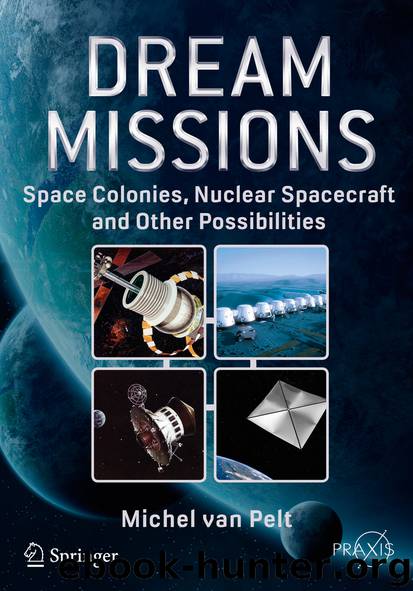Dream Missions by Michel van Pelt

Author:Michel van Pelt
Language: eng
Format: epub
Publisher: Springer International Publishing, Cham
Hypersatellites and star shades
Over the relatively short history of spaceflight, several concepts for more substantial satellites have nevertheless been dreamed up. Interestingly, whereas the most ambitious and largest ideas for crewed concepts tend to be among the oldest, many of the ‘super satellite’ studies are actually quite recent.
Without Saturn V -class launchers available, however, these satellite ideas typically foresee multiple spacecraft elements that are individually launched and partly operated as stand-alone satellites, rather than being single-units. These then combine to form a much larger assembly, known as a ‘fractionated spacecraft’, with capabilities that are beyond that of any reasonably sized single-unit (‘monolithic’) system. That such concepts have only emerged fairly recently is not that surprising, as they typically require spacecraft formation-flying technology that has only been developed in the early 21st century. Such possibilities apparently went unforeseen until the 1990s, and the term ‘fractionated spacecraft’ was in fact only coined in 2006.
Take for instance XEUS , the X-ray Evolving Universe Spectroscopy mission, which was an X-ray space telescope that ESA studied in the late 1990s and which was planned to be launched by 2010. It would have had a telescope aperture equivalent to the largest ground-based optical telescopes. XEUS needed to be launched into space, orbiting the Earth at 600 km altitude, because the Earth’s atmosphere prevents x-rays from space reaching the ground. However, the giant telescope needed a focal length, i.e. the distance between the X-ray ‘lens’ and the scientific detectors, which was so long that it would have made the spacecraft much too tall to fit inside an Ariane 5 , or in fact any other available launcher.
For this reason, XEUS would effectively have consisted of two separate spacecraft flying in formation some 50 meters apart. One would have contained the X-ray mirror and the other would have housed the detectors. The detector spacecraft would follow the orientation of the mirror spacecraft, using a laser range finder to maintain a relative position to an accuracy of +/- one cubic millimeter.
This formation flying concept would take care of the launcher’s payload fairing constraint in terms of length, which is 17 meters for Ariane 5 , but would still limit the diameter of the X-ray mirror spacecraft to less than 5.4 meters if it was going to fit within the launcher. But an innovative solution was found for that problem. After an initial operational flight of four to six years, the mirror spacecraft would then rendezvous and dock with the International Space Station (ISS) . Using the station’s robotic arm, astronauts would then expand the mirror using a ring of additional X-ray reflecting sections that had been flown up by the Space Shuttle, after which the mirror spacecraft would undock, rejoin the detector spacecraft and continue its mission in enhanced form as XEUS -2. Subsequent visits to the ISS would then enable maintenance and further upgrades, including outfitting the detector spacecraft with new generations of instrumentation, similar to how the Hubble Space Telescope was periodically upgraded through a number of Space Shuttle servicing missions.
Download
This site does not store any files on its server. We only index and link to content provided by other sites. Please contact the content providers to delete copyright contents if any and email us, we'll remove relevant links or contents immediately.
| Aerodynamics | Aircraft Design & Construction |
| Astronautics & Space Flight | Avionics |
| Gas Dynamics | Propulsion Technology |
Whiskies Galore by Ian Buxton(41867)
Introduction to Aircraft Design (Cambridge Aerospace Series) by John P. Fielding(33064)
Small Unmanned Fixed-wing Aircraft Design by Andrew J. Keane Andras Sobester James P. Scanlan & András Sóbester & James P. Scanlan(32743)
Craft Beer for the Homebrewer by Michael Agnew(18140)
Turbulence by E. J. Noyes(7935)
The Complete Stick Figure Physics Tutorials by Allen Sarah(7307)
Kaplan MCAT General Chemistry Review by Kaplan(6866)
The Thirst by Nesbo Jo(6826)
Bad Blood by John Carreyrou(6543)
Modelling of Convective Heat and Mass Transfer in Rotating Flows by Igor V. Shevchuk(6391)
Learning SQL by Alan Beaulieu(6208)
Weapons of Math Destruction by Cathy O'Neil(6139)
Man-made Catastrophes and Risk Information Concealment by Dmitry Chernov & Didier Sornette(5921)
Digital Minimalism by Cal Newport;(5661)
Life 3.0: Being Human in the Age of Artificial Intelligence by Tegmark Max(5474)
iGen by Jean M. Twenge(5366)
Secrets of Antigravity Propulsion: Tesla, UFOs, and Classified Aerospace Technology by Ph.D. Paul A. Laviolette(5309)
Design of Trajectory Optimization Approach for Space Maneuver Vehicle Skip Entry Problems by Runqi Chai & Al Savvaris & Antonios Tsourdos & Senchun Chai(5011)
Electronic Devices & Circuits by Jacob Millman & Christos C. Halkias(4907)
